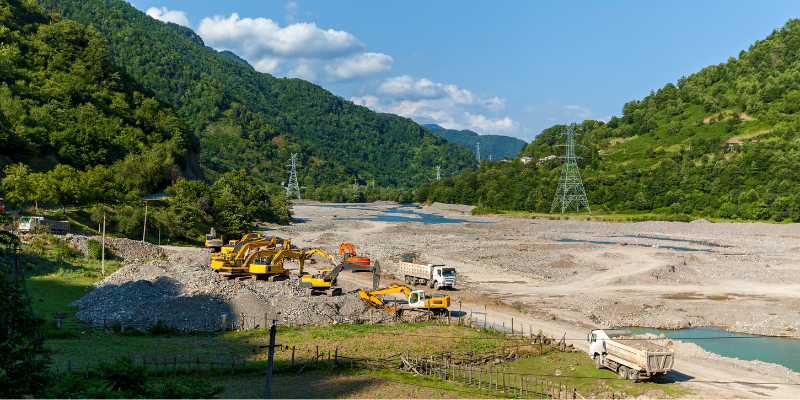Have you ever visited a beautiful urban park and marveled the vibrant landscape only to learn that it was once an industrial site? This is the transformative potential of environmental remediation.
In this article, we’ll outline the core processes and methods used in environmental remediation as well as answer common questions we see in the industry.
What Is It
Environmental remediation is the process of removing pollutants and contaminants from the environment, primarily from soil, groundwater, sediment, or surface water, to protect human health and restore natural ecosystems.
How It Happens
When a professional remediation team is engaged, they follow a structured process to ensure thorough and effective cleanup. Generally, the steps they follow will look something like this:
- Identification of contaminants and extent of pollution through soil sampling, groundwater testing, and site surveys.
- Evaluating the potential risks to human health and the environment to determine the urgency and type of remediation required.
- Remediation Planning:
- Analyzing different remediation methods to determine the most effective and cost-efficient approach.
- Ensuring that the planned remediation meets all local, provincial, and federal environmental regulations.
- Remediation Methods:
- Techniques like excavation, dredging, and soil washing to physically remove contaminants.
- Chemical agents are used to neutralize or stabilize contaminants, making them less harmful.
- Bioremediation is done by employing microorganisms or plants to naturally degrade pollutants.
- Thermal remediation is done by applying heat to volatilize or destroy contaminants in soil and groundwater.
- Implementation:
- Clearing the site and setting up the necessary infrastructure to prepare for the remediation process.
- Applying the chosen remediation techniques, continuously monitoring progress, and adjusting as needed to ensure effectiveness.
- Post-Remediation Monitoring:
- Regularly testing soil, water, and air to ensure that contamination levels remain below regulatory thresholds.
- Implementing long-term maintenance plans to prevent recontamination and manage residual risks.
What’s required for effective environmental remediation?
Effective environmental remediation demands a multifaceted approach involving expertise, technology, regulatory knowledge, collaboration, financial resources, and long-term monitoring.
- Technical Expertise:
- A skilled team with knowledge of environmental science, engineering, and regulatory requirements.
- Advanced Technology:
- Utilizing modern equipment and innovative technologies for accurate assessment and efficient remediation.
- Regulatory Knowledge:
- Understanding and complying with all environmental laws and regulations to avoid legal and financial penalties.
- Collaboration:
- Working closely with stakeholders, including government agencies, community members, and industry partners, to ensure transparent and effective remediation efforts.
What are the common contaminants found in environmental remediation?
Common contaminants include heavy metals like lead, mercury, and arsenic, which can originate from industrial activities, mining, and improper waste disposal.
Organic pollutants such as petroleum hydrocarbons, solvents like trichloroethylene, and pesticides are also frequent targets. These contaminants pose serious risks to human health and the environment, requiring detailed site assessments to identify their presence and concentration levels.
Remediation efforts focus on these substances due to their persistence and potential to cause long-term damage to ecosystems and water sources.
How long does the environmental remediation process take?
The duration of environmental remediation can vary significantly based on the size of the site, the extent and type of contamination, and the chosen remediation method. For instance, soil excavation might be completed in a few months, while bioremediation can take several years to achieve the desired results.
Detailed planning and regulatory approvals also impact timelines. Continuous monitoring and potential re-treatment may extend the process, but thorough remediation is crucial for ensuring long-term safety and compliance with environmental standards.
What are the common challenges faced during environmental remediation?
Challenges in environmental remediation include accurately identifying the extent of contamination, selecting appropriate and effective remediation methods, and ensuring compliance with complex regulatory requirements. Technical difficulties, such as dealing with mixed contaminant sites or inaccessible locations, can complicate efforts. Financial constraints and stakeholder coordination also pose significant hurdles.
Effective communication, thorough planning, and adaptive management strategies are essential to overcoming these challenges and achieving successful remediation outcomes.
How is the success of remediation efforts measured?
The success of remediation efforts is measured through comprehensive post-remediation monitoring, which involves regular testing of soil, water, and air samples to ensure that contaminant levels are reduced to acceptable standards set by regulatory bodies.
This process includes the use of chemical analyses and environmental indicators to verify the effectiveness of the remediation methods employed. Achieving compliance with health and safety regulations is a key indicator of success, and ongoing monitoring helps to detect any potential recontamination, ensuring long-term site safety.
What are the risks of not performing environmental remediation?
Neglecting environmental remediation poses significant risks, including long-term health hazards such as:
- Cancer
- Neurological disorders
- Skin conditions
- Respiratory issues
- Other chronic issues are due to exposure to pollutants.
Environmental risks include the contamination of
- Groundwater
- Rivers, lakes and streams
- Ocean inlets and straights
- Soil
- Air
All of which can lead to ecosystem degradation and loss of biodiversity.
Financial risks involve potential legal liabilities, regulatory fines, and decreased property values. Additionally, unaddressed contamination can hinder land use and development, affecting economic growth and community well-being.
Can contaminated sites be used during or after remediation?
Contaminated sites can often be used during remediation with proper safety measures, such as containment systems and restricted access areas, to protect workers and the public. After remediation, sites are typically safe for their intended use once they meet regulatory standards for contaminant levels. This clearance involves rigorous testing and validation processes to ensure all remediation goals are achieved.
Post-remediation land use varies from residential and commercial development to recreational spaces, depending on the site’s suitability and regulatory compliance.
What role do government regulations play in environmental remediation?
Government regulations are crucial in guiding environmental remediation processes. They set acceptable contaminant levels, outline assessment and remediation procedures, and ensure public health and environmental safety.
What is bioremediation and how does it differ from other remediation methods?
Bioremediation utilizes natural organisms, such as bacteria, fungi, and plants, to degrade or neutralize contaminants, offering an eco-friendly and cost-effective alternative to physical and chemical methods. Unlike methods like excavation or chemical treatment, bioremediation can be less intrusive and more sustainable, as it often uses naturally occurring processes to detoxify pollutants. This method is particularly effective for organic contaminants and can be applied in situ, minimizing disruption to the site and surrounding environment.
Examples of Successful Environmental Remediation Projects
Globally renowned environmental remediation projects include the cleanup of the Exxon Valdez oil spill, where bioremediation and physical cleanup methods restored the Alaskan shoreline. Another example is the Love Canal site in New York, where extensive soil and groundwater remediation transformed a hazardous waste site into a safe residential area.
Successful remediation projects undertaken by the Nichols team include:
1. Natural Source Zone Depletion
In Kerrobert, SK, Nichols Environmental worked with specialists to implement a Natural Source Zone Depletion project in the fall of 2020. This involved using natural processes to reduce contaminant concentrations in the environment, restoring the site and ensuring long-term environmental health.
2. Spill Response – Wheatland County, AB
In Wheatland County, AB, a transport truck crashed into a creek, releasing fuel and cargo. Nichols Environmental responded by immediately cleaning up the fuel and later removing debris from the creek with the help of a commercial dive team. The project spanned from March to September 2020 and showcased their ability to manage complex spill response and remediation tasks effectively.
3. Spill Response – Invermere, BC
In July 2019, Nichols Environmental responded to a spill in Invermere, BC, caused by a snowmobile sinking into a lake. The team undertook immediate recovery and remediation efforts to address the fuel spill’s impact on the local environment.
These projects highlight the importance of thorough planning, innovative technologies, and regulatory collaboration in achieving effective remediation and restoring environmental health.
Work With Remediation Experts Today
Environmental remediation is a multifaceted process involving assessment, planning, implementation, and monitoring to effectively address and mitigate environmental contamination. By harnessing technical expertise, cutting-edge technology, and regulatory knowledge, Nichols Environmental delivers tailored solutions to restore and safeguard our ecosystems.
For more detailed information on how Nichols Environmental can assist with your remediation needs, contact us today. Let’s work together to celebrate a cleaner, healthier planet.

